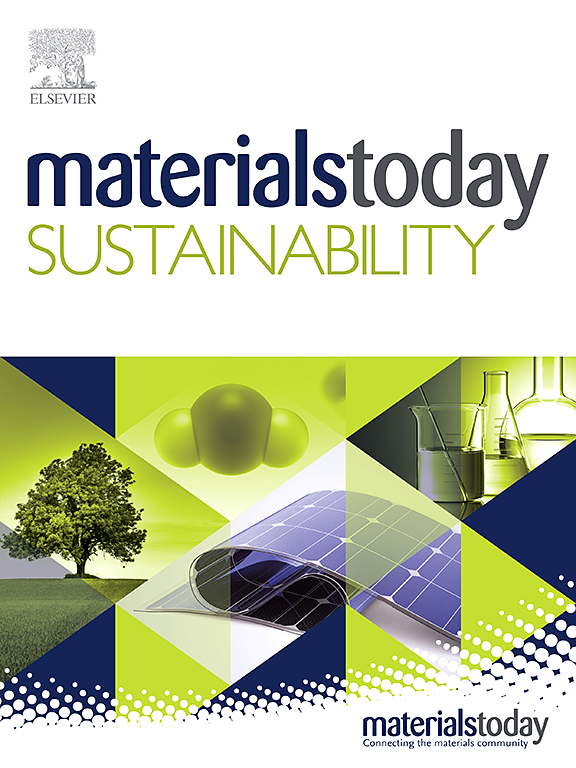Zinc-spray-coated carbon fibres as lean anodes for low-cost zinc-ion batteries
IF 7.9
3区 材料科学
Q1 GREEN & SUSTAINABLE SCIENCE & TECHNOLOGY
引用次数: 0
Abstract
While moving towards sustainable Zn-ion batteries (ZIBs), it is crucial to research not only on their critical issues, such as dendrite growth, hydrogen evolution reaction (HER), and corrosion, but also on the sustainable utilization of spent materials. Lean anodes, which utilize reduced amounts of zinc, are pivotal in this context; however, the batteries reported in literature have yet to achieve superior performance levels. In this study we present a simple cost-effective approach of zinc spray coating onto carbon fibre substrate (SCZn) as a simplified lean anode production strategy while enhancing the performance of Zn-ion batteries. This SCZn anode demonstrates remarkable cyclability over 1000 cycles at 0.5 mA cm−2 with a 0.5 mAh cm−2 capacity, and 10 times the anodic depth of discharge (DOD) when compared to a standard Zn foil anode (FZn). Furthermore, the micro-scaled Zn particles embedded in the 3D structure of the carbon fibres effectively supress dendrite growth and enhance the charge transfer kinetics, as evidenced by lower polarization, less corrosion and favourable impedance. Full cell studies were carried out by pairing the SCZn anode with a cost-effective commercial V2O5-based cathode. The latter shows impressive performance with a 370 mAh g−1 specific capacity at 0.1 A g−1, and 270 mAh g−1 with a capacity retention of 95 % over 760 cycles under current density of 1 A g−1. The proposed anode preparation method is highly scalable, cost-effective and ultimately simple. This paves the way for long-life, efficient, and durable Zn-ion batteries, offering an opportunity to engineer sustainable solutions for future grid scale energy storage applications.

锌喷涂碳纤维作为低成本锌离子电池的精益阳极
在发展可持续锌离子电池的过程中,不仅要研究其关键问题,如枝晶生长、析氢反应(HER)和腐蚀,还要研究废材料的可持续利用。在这种情况下,利用少量锌的贫阳极是关键;然而,文献中报道的电池尚未达到卓越的性能水平。在这项研究中,我们提出了一种简单的成本效益的方法,即在碳纤维基体上喷涂锌(SCZn),作为一种简化的精益阳极生产策略,同时提高了锌离子电池的性能。与标准锌箔阳极(FZn)相比,该SCZn阳极在0.5 mA cm - 2下具有0.5 mAh cm - 2容量,在1000次循环中具有显着的可循环性,并且阳极放电深度(DOD)是其10倍。此外,嵌入碳纤维三维结构中的微尺度锌颗粒有效地抑制了枝晶的生长,增强了电荷传递动力学,表现出更低的极化、更少的腐蚀和有利的阻抗。通过将SCZn阳极与具有成本效益的商用v2o5基阴极配对,进行了全电池研究。后者表现出令人印象深刻的性能,在0.1 a g−1时的比容量为370 mAh g−1,在1 a g−1电流密度下,270 mAh g−1的容量保持率为95%,超过760次循环。所提出的阳极制备方法具有高度可扩展性、成本效益和简单性。这为长寿命、高效、耐用的锌离子电池铺平了道路,为未来电网规模的储能应用提供了设计可持续解决方案的机会。
本文章由计算机程序翻译,如有差异,请以英文原文为准。
求助全文
约1分钟内获得全文
求助全文
来源期刊

Materials Today Sustainability
Multiple-
CiteScore
5.80
自引率
6.40%
发文量
174
审稿时长
32 days
期刊介绍:
Materials Today Sustainability is a multi-disciplinary journal covering all aspects of sustainability through materials science.
With a rapidly increasing population with growing demands, materials science has emerged as a critical discipline toward protecting of the environment and ensuring the long term survival of future generations.
 求助内容:
求助内容: 应助结果提醒方式:
应助结果提醒方式:


